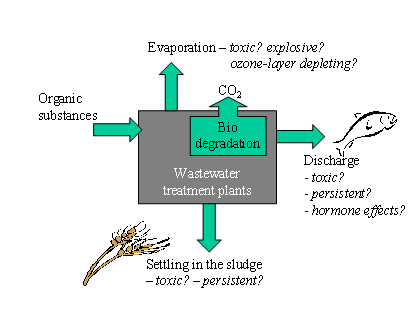

|
Introduction |
|
Why be concerned? |
|
Supplier progress |
|
Potential impacts |
|
Functional groups |
|
Substance list |
|
Legislation / REACH |
|
FAQs |
|
Related Links |
|
Wash with care |



|
Environmental assessment of laundry detergents |
|
Wastewater from industrial laundries is generally treated either in the municipal wastewater treatment plants or in separate industrial wastewater treatment plants. Detergent ingredients may in principle have four different outcomes in the treatment plant: · They may completely biodegrade and finish up as carbon dioxide and water, · they may be absorbed into the sludge produced in the treatment plant, · they may be discharged with the treated wastewater, or · they may evaporate (rarely the case for detergent substances as they do not include solvents).
|
|
The majority of substances used in detergents are readily biodegradable, meaning that they will degrade rapidly in wastewater treatment plants or in the environment.
When chemical substances reach the receiving water- ‘the aquatic environment’- before complete biodegradation the potential effect becomes important. The chemical properties of the most often used detergent substances are described in the section ‘functional groups’, which also includes examples of substances that are generally phased out and the reason why. More theory Three key aspects determines the outcomes and effects of the detergent substances on the environment: · The biological degradability · The potential to bio-accumulate The outcomes are determined by the chemical nature of the substances — what the eco-toxicologists call the ‘inherent properties’. More specific definitions and descriptions of the tests used to determine these properties are found via the links above. EU and national legislative framework use these inherent properties for the regulation of detergents. For example, see how the EU system for classification of hazardous chemicals and preparation uses these properties. (For further information on EU legislation please consult the ‘legislation’ section). |
|
Potential impacts |
|
Pre-treatment of waste water: Some substances on the soiled textiles are harder to treat in the municipal wastewater treatment plants, including heavy metals, oils and other persistent substances. Such substances might accumulate in the sludge from the treatment plants, hence preventing beneficial use of the sludge. Therefore many industrial laundries ‘pre-treat’ their wastewater before discharging it into the public sewer system. Thus laundries contribute to ‘cleaning’ the sludge - an option not possible if soiled work wear is washed in households. |
|
Further reading - books:
Handbook of detergents, part B, 2003 - in particular chapter 8: Biodegradability and Toxicity of Surfactants by Torben Madsen, DHI Purchase at www.dekker.com Environmental and health assessment of substances in household detergents and cosmetic detergent products, 2001 - from the Danish EPA Free download at www.mst.dk |